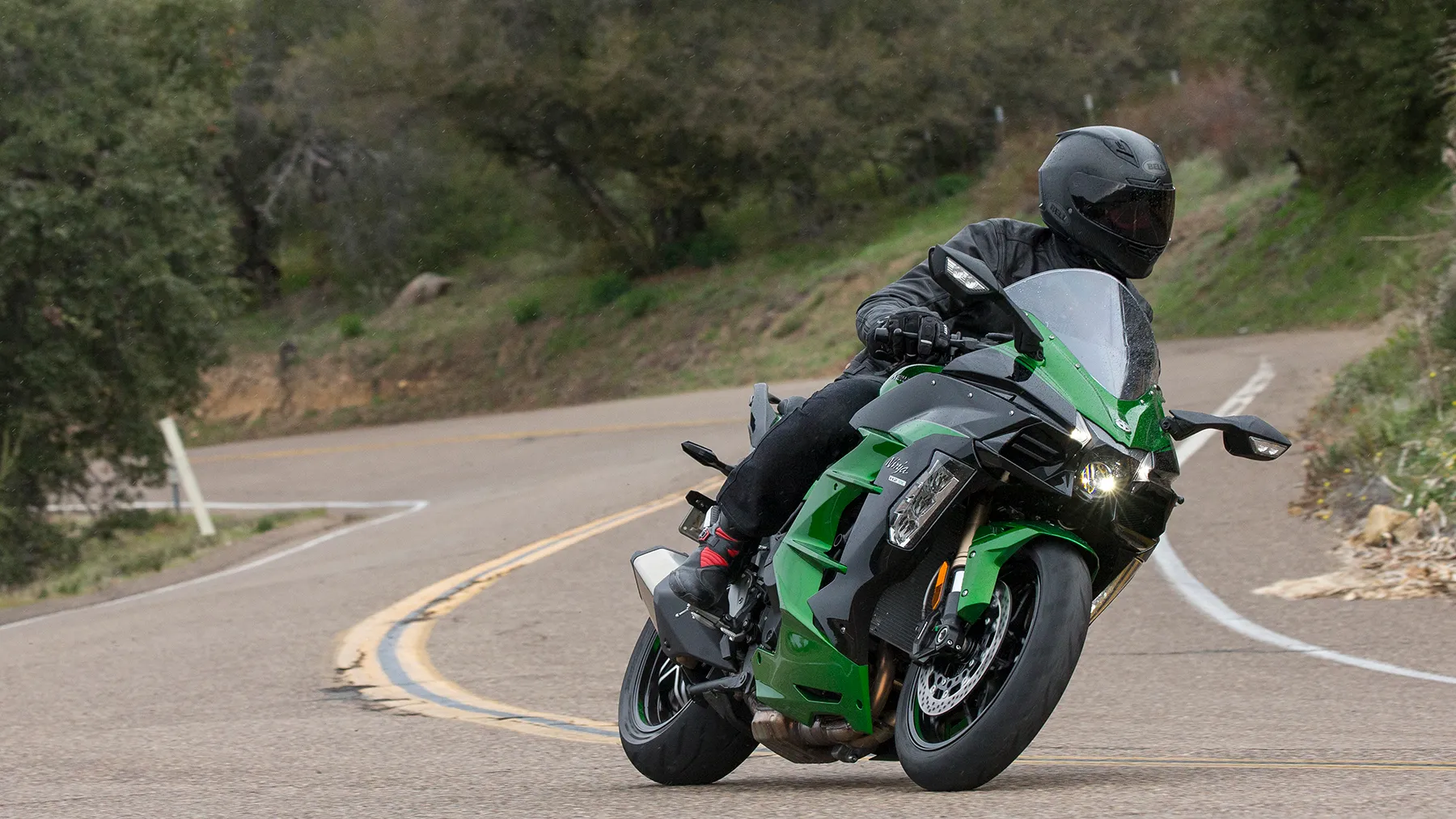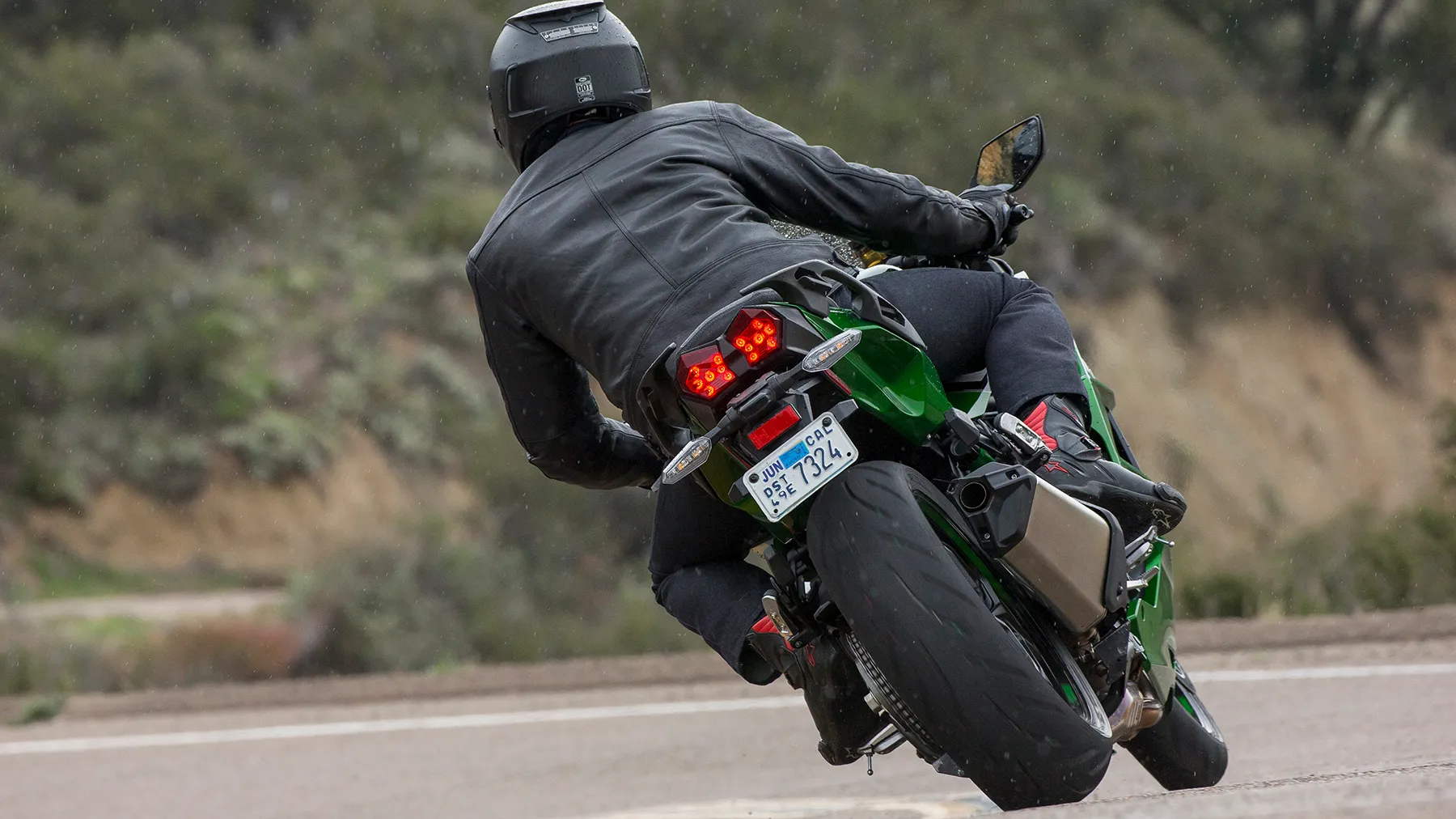

We may earn revenue from the products available on this page and participate in affiliate programs. Learn more ›
Kawasaki’s latest member of the Ninja H2 family is a supercharged, 200 hp sport bike with saddlebags. There’s more electronics and features standard than most sports cars, and a better hp-to-weight ratio to boot.
The bike is a mix of crazy speed and comfort. As Kawasaki puts it: “The Ninja H2 SX is the “Supercharged Sportbike” offering the most desirable street qualities of Hyperbikes, Sportbikes and Sport Touring bikes.” It is, in short, wonderfully excessive.
What’s An H2?
In 1971, Kawasaki set the world ablaze with the introduction of the fastest production motorcycle ever: the H2. A two-stroke (whice means no valve train) with a 7,500 RPM redline (high for the time) and a 1:1 horsepower-to-weight ratio. It would wheelie over backwards on an inexperienced rider, and beat your friends to every red light—but you’d also likely blow through that red light. The original H2 was nicknamed the Widowmaker for its ridiculous power and lackluster brakes and suspension. It was dangerously fast.
Fast forward to 2015. Kawasaki reintroduces the H2 as the Ninja H2R, a 300hp race-only bike and again, the world’s fastest production motorcycle. Kawasaki has introduced a new version of the Ninja H2 every year since.
In 2016, the Ninja H2 was announced with 100 fewer horsepower, $25,000 cheaper, and a license plate. To round out a trio. Kawasaki introduced the H2 SX—the H2 you can ride everyday.

What Is It?
Like its convoluted name, the bike was a conundrum when first introduced. It’s a sportbike with touring features, 200 hp, tons of electronics and a supercharger; no other motorcycle on the market can be described this way.
“It’s a cross between a hyperbike, sport bike and sport touring bike,” said Kawasaki product manager Croft Long. “There’s no competition.”
Sitting idle in a parking lot staring into Kawasaki’s first color LCD gauges reminds me of doing the same in a Chevy Camaro ZL1. I toggle between track modes, traction control settings, and display options. Do I want a colorful background, or black and white? Oh, the choices.

The are similar options between the Chevy and the motorcycle, but with different names. The Kawasaki doesn’t have “track mode,” like in the ZL1; instead it’s “Mode 1.” Then there’s power level: Full, Medium, or Light. I opted for Medium (whatever that says of my personality).
The only difference is the ZL1 has four wheels, the Kawi has two. Well, that and the bike has twice the horsepower-to-weight ratio, with the H2 making one horsepower per every 2.87 pounds and the car making the same horsepower per 6.15 lbs.
Like the ZL1, few customers will actually track the H2 SX, despite its capability. According to Long, less than 20 percent of ZX-10R riders take their bikes to the track—and that’s the track-focused bike—so he expects even fewer with the H2 SX.
It should be noted there’s actually two bikes we’re talking about. Don’t be fooled when you hear the $19,000 price tag; that’s for the base H2 SX model. The motorcycle pictured here and reviewed was the H2 SX SE, the Special Edition with a slew of standard upgrades including grip warmers, center stand, flashy paint, braided brake lines, and super trick, lean-angle-sensitive fairing-mounted fog lights. It retails for $22,000.
Just like with the Z900 vs. Z900RS, you’d assume the H2 family shares the majority of the same parts—cheaper manufacturing, right? Instead, this new H2 SX SE, like the Z900RS, features a new chassis, tons of new engine parts, and a new user interface.
In terms of price, there are bikes out there with similar if not more power, but none with the versatility of the H2 SX. To best understand what it is, you must understand what it does well: everything.

Engine
H2 SX’s 1000cc inline-four engine feels like a docile engine during normal riding, but turn on the boost and it comes screaming to life like Frankenstein’s monster. Luckily, power is on tap anywhere in the RPM range.
Normally, an in-line four cylinder requires a long pause in power while revs build. Kawasaki has a majestic solution to this problem: a supercharger. The only bike on the market from a major manufacturer with a supercharger.
Engineers set out to make a more street-friendly power curve, meaning the bike makes more power lower in the rpm range. Around town during normal riding with a close ratio transmission, you’re often in the sweet spot around 5,000-6,500 rpm.
The Ninja H2 SX makes approximately 100 hp at 6,500 rpm and the full 200 hp around 10,500 rpm (with a 12,500 rpm redline). That’s significantly lower than the other H2 models but resulting in a beautiful, rev-me-anytime throttle response that’s ideal for street riding.

At that speed you’re also accompanied by a symphony of sounds as the supercharger whistles and then chirps during aggressive downshifts. It’s purposeful, as engineers designed a “sound hole” in the intake duct to amplify the noise. According to Kawasaki, the chirp is a mini sonic boom.
The supercharger direct planetary gear spins 9.2 faster than the crankshaft so revs build directly with pressure. The supercharger’s propeller is a work of art, built by a five-axis CNC machine, with a high pumping capacity.
There’s a much higher engine compression, too: 11.2:1 over the H2’s 8.5:1, along with a redesigned, stronger piston. The now more efficient combustion chamber produces less heat, so there’s only one oil jet per piston, resulting in a 300 percent reduction in the oil-pump volume.
The throttle valves are also 10mm smaller than the H2 for better low-mid range torque and fuel efficiency. Varied length intake runners create a good tuning for low and high rpm. With efficiency in mind, the engineers retouched almost every part of the H2 SX’s engine.
The engine is incredibly smooth and feels like it’s never being overworked thanks in large part to the supercharger. I never felt that shift-me-now vibration, and occasionally found myself in low gear.

Transmission
Smooth shifts are courtesy of the dog-ring transmission, where the gears fixed to the input shaft and the rings are moving around them to engage between the output shaft, as opposed to the gears themselves moving; similar technology is found in MotoGP bikes. This design leads to lighter shifting, quicker shifts, and an improved shift feel. Transmission oil jets at every gear mesh and shift fork position, providing direct cooling and lubrication for high durability.
The electronic pointless quick shifter is a thing of magic—and standard equipment on the H2 SX SE. The auto blip downshifts and no need for a clutch, other than stopping, had me spoiled for the ride. It won’t allow for mis-shifts, as it only upshifts under throttle and downshifts off throttle. You don’t need to be riding aggressively to use it either; you’ll feel as though you have John Force-like shifting ability.
Ergonomics
“It’s the perfect blend of exhilarating power and performance paired with comfort and efficiency,” said Kawasaki Marketing Manager Ken Essex. While it’s near perfect, you must anticipate the Ninja H2 SX within it’s realm of reality. It’s still a sport bike, more upright and relaxed than ZX-14R but not as upright as the Ninja 1000. There’s a possibility of upright controls from Kawasaki accessories, but nothing is confirmed as of now. After six hours of riding, my wrists and butt were sore, and I longed for the ergonomics of the Ninja 1000.
Foot pegs are mounted high—a sport bike trait—but the rider triangle is open, granting you room to shift around. The H2 SX is also big; it’s hard to hide its weight in a parking lot, despite Kawasaki’s best efforts (the engine is tiled forward to lower the center of gravity, for example), but once at speed it’s not a bother. Still, the seats are hard and the passenger seat isn’t as big as a touring bike. Still, these are all problems inherent with the sportiness of the bike. The limited touring doesn’t limit fun.

Pricing
The standard model Kawasaki H2 SX retails for $19,000. Kawasaki adds on a ton of accessories to the H2 SX SE, which makes the base model SX seem like a poor purchase. As mentioned, we tested the H2 SX SE only, $22,000 at retail, with the one-key Kawasaki Quick Release hard 28-liter saddlebag set, which retails for $1,214.76. Price as tested: $23,214.76.
Taking a broad look at the numbers, if you spend an additional $600 in taxes, tags, and dealership fees, with a 6.6 percent interest rate, your payments are around $390 a month; for the SX SE you’re looking at $440. That’s a $50 monthly charge.
“When comparing it to other bikes in the same price range, they don’t have the supercharger and power. If you compare it with other supercharged bikes, they have no versatility. It’s almost a cross between hyperbike, sport bike, and sport touring.” said Product Manager Croft Long.
It’s difficult to compare to another bike in the market. A Harley-Davidson dresser or Honda Goldwing are way down on power and handling, but up on touring and weight. A true sport bike like a Yamaha R1 is cheaper, but also down on power, and Yamaha doesn’t offer hard saddlebags.
Some might not know exactly what the Ninja H2 SX SE is, but KTM apparently does, as the company offers a touring version of its Super Duke R. It makes 20 less horespower, but makes its peak power over 1,000 rpm sooner, and makes more torque 600 rpm sooner than the H2 SX—and KTM offers saddlebags!
The KTM retails for $19,999. Similar to the H2 SX SE, you need slightly more dough for the goodies. KTM offers a “Track/Performance Pack,” which adds $1,000 to the MSRP, along with a quick shifter and adjustable electronics, but still comes slightly short of the standard equipment on the Kawasaki. The Kawasaki is good, but is the KTM great? Comparisons shootouts will be fun to watch this year.

Final Thoughts
Finding faults other than price is difficult on a motorcycle like this. You pay a lot, but hey, you get a lot. A hard and uncomfortable seat are accompanied by a squishy front brake lever—that’s about it for gripes. The rest of my complaints are inherent to any sport bike: I wanted handlebars and a slightly less aggressive seating position, but if I only commuted or did weekend canyon runs with friends (the majority of customers will barley do the latter, probably) I’d be very happy with this bike. At the end of the ride it had me asking: Does the market need a motorcycle like this?
I’m not sure about the market, but I know I want one.

Gear
The gear journalists wore on the media launch for the Ninja H2 SX SE provided insight on how others saw the bike in the market. Some of the faster guys donned full leather racing suits, others wore adventure gear. Me, I went with a mix of a stylish leather jacket, jeans, racing shoes, and helmet:
Roland Sands Walker leather jacket(with padding)
